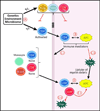Modeling the heterogeneity of multiple sclerosis in animals
- PMID: 23707039
- PMCID: PMC3752929
- DOI: 10.1016/j.it.2013.04.006
Modeling the heterogeneity of multiple sclerosis in animals
Abstract
Multiple sclerosis (MS) is an inflammatory, demyelinating disease of the central nervous system (CNS) manifested with varying clinical course, pathology, and inflammatory patterns. There are multiple animal models that reflect different aspects of this heterogeneity. Collectively, these models reveal a balance between pathogenic and regulatory CD4(+) T cells, CD8(+) T cells, and B cells that influences the incidence, timing, and severity of CNS autoimmunity. In this review we discuss experimental autoimmune encephalomyelitis (EAE) models that have been used to study the pathogenic and regulatory roles of these immune cells; models that recapitulate different aspects of the disease seen in patients with MS, and questions remaining for future studies.
Keywords: animal models; autoimmunity; experimental autoimmune encephalomyelitis; multiple sclerosis; neuroimmunology.
Copyright © 2013 Elsevier Ltd. All rights reserved.
Figures

References
-
- Gay FW, et al. The application of multifactorial cluster analysis in the staging of plaques in early multiple sclerosis. Identification and characterization of the primary demyelinating lesion. Brain. 1997;120(Pt 8):1461–1483. - PubMed
-
- Noseworthy JH, et al. Multiple sclerosis. N Engl J Med. 2000;343:938–952. - PubMed
-
- Lassmann H, et al. Progressive multiple sclerosis: pathology and pathogenesis. Nature reviews. Neurology. 2012;8:647–656. - PubMed
Publication types
MeSH terms
Grants and funding
- F30 NS071712/NS/NINDS NIH HHS/United States
- AI072737/AI/NIAID NIH HHS/United States
- R01 AI072737/AI/NIAID NIH HHS/United States
- AI073748/AI/NIAID NIH HHS/United States
- P01A1073748/PHS HHS/United States
- AI073726/AI/NIAID NIH HHS/United States
- NS071712/NS/NINDS NIH HHS/United States
- R01 NS035126/NS/NINDS NIH HHS/United States
- R01 AI073726/AI/NIAID NIH HHS/United States
- T32 CA009537/CA/NCI NIH HHS/United States
- T32CA009537/CA/NCI NIH HHS/United States
- P01 AI073748/AI/NIAID NIH HHS/United States
- T32 GM007266/GM/NIGMS NIH HHS/United States
LinkOut - more resources
Full Text Sources
Other Literature Sources
Medical
Research Materials

